Replaces
2011 GMC Yukon XL 1500 with Cast Iron Lower Control Arms Front 6 Piece Steering & Suspension Kit TRQ PSA59695
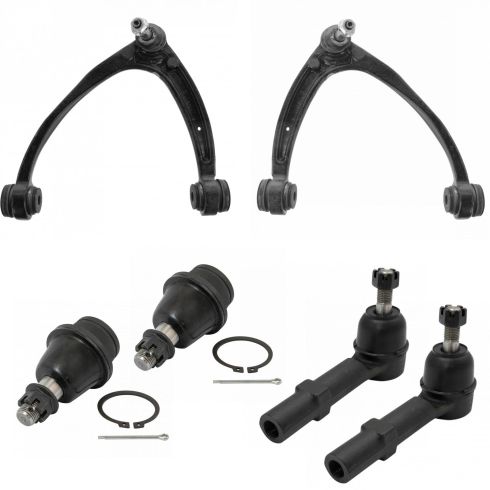

PSA59695
In Stock
This part doesn’t fit a . Select from parts that fit.
Specify your vehicle's year, make and model to guarantee fit.
Orders must be placed by 2pm ET
You may also like
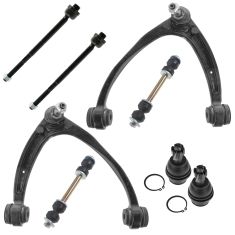
8 Piece Steering & Suspension Kit
$154.95
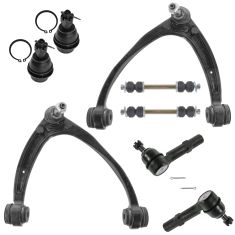
8 Piece Steering & Suspension Kit
$159.95
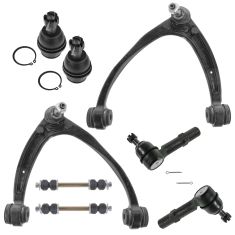
8 Piece Steering & Suspension Kit
$164.95
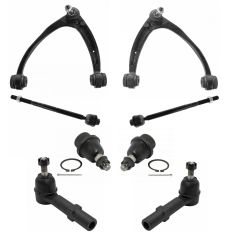
8 Piece Steering & Suspension Kit
$169.95
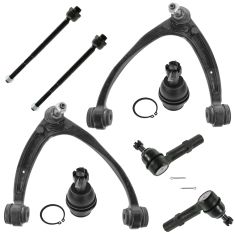
8 Piece Steering & Suspension Kit
$169.95
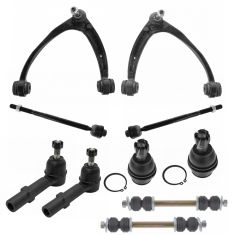
10 Piece Steering & Suspension Kit
$174.95
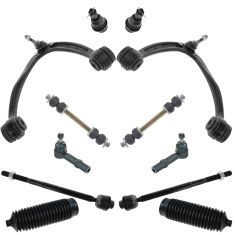
12 Piece Steering & Suspension Kit
$189.95
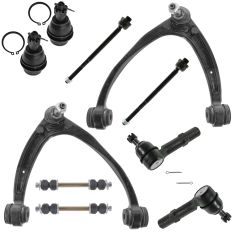
10 Piece Steering & Suspension Kit
$189.95
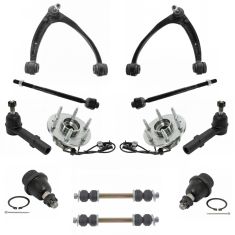
12 Piece Steering, Suspension, & Drivetrain Kit
$339.95
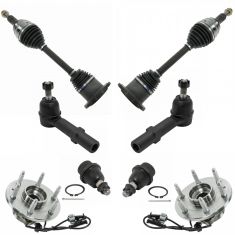
8 Piece Steering, Suspension, & Drivetrain Kit
$339.95
Part Details
- Quantity: 6 Piece
-
Kit Includes:
(2) Front Lower Ball Joints
(2) Front Upper Control Arms with Ball Joints
(2) Front Outer Tie Rods
Specification
- with Cast Iron Lower Control Arms
- Front
TRQ suspension kits are manufactured using premium raw materials and coatings for extended service life. Each TRQ suspension component is designed to be a direct, maintenance-free replacement to the stock unit. To extend the life of your steering and suspension components, TRQ recommends replacing components in pairs, sets, or kits. All products are fit and road-tested in our Massachusetts R&D facility to ensure we deliver on our promise of Trusted Reliable Quality.
Product Features
Install Tip: When replacing steering components, have a professional alignment performed afterwards. This ensures proper tracking and even tire wear.
Our steering and suspension components are pre-greased and sealed for long life and do not require the extra maintenance typically required by greaseable versions.
Item Condition:
New
Attention California Customers:
![]() WARNING: This product can expose you to chemicals including Lead and Lead Compounds, which are known to the State of California to cause cancer, and birth defects or other reproductive harm. For more information, go to www.P65Warnings.ca.gov.
WARNING: This product can expose you to chemicals including Lead and Lead Compounds, which are known to the State of California to cause cancer, and birth defects or other reproductive harm. For more information, go to www.P65Warnings.ca.gov.
Lifetime Warranty
This item is backed by our limited lifetime warranty. In the event that this item should fail due to manufacturing defects during intended use, we will replace the part free of charge. This warranty covers the cost of the part only.
FREE Shipping is standard on orders shipped to the lower 48 States (Contiguous United States). Standard shipping charges apply to Hawaii and Alaska.
Shipping is not available to a P.O. Box, APO/FPO/DPO addresses, US Territories, or Canada for this item.
Expedited is available on checkout to the United States, excluding Alaska, Hawaii.
Final shipping costs are available at checkout.










Created on:
Tools used
- Pull the wire off the 18mm nut on top of the strut Remove the three 18mm nuts that hold the top of the strut
- Pry off the center cap with a flat blade screwdriver Loosen the 22mm lug nuts with the vehicle on the ground Raise the vehicle with a floor jack Secure the vehicle on jack stands Remove the lug nuts Pull off the wheel
- Turn the wheel by hand or with the steering wheel Apply penetrating oil to the top of the stabilizer link Use a wrench on top and a socket underneath to remove the stabilizer link Push down on the suspension and remove the stabilizer link
- Remove two 15mm bolts from the bottom of the strut Push down on the suspension, pull the strut down, and then pull it up and out
- Apply penetrating oil to the control arm bolts Use a marker to mark the control arm washer tabs for future reference Loosen the 18mm nut that holds the ball joint to the steering knuckle Pry on the steering knuckle with a pry bar and hit it with a hammer until it pops apart Remove the 10mm bolt that holds the wiring harness clip to the control arm Support the suspension with a jack Remove the 21mm nuts from the control arm using a ratchet and a pipe for leverage Drive the bolts out with a hammer, and a punch if necessary Remove the nut from the ball joint Pull out the control arm with a pry bar
- Install the grease-able fitting on to the new ball joint Put the control arm into place and line it up Start the bolts that hold the control arm to the frame by hand Tap the bolts in with a hammer Start the 21mm nuts by hand With a wrench on each side of the bolt, realign the bolt mark with the tab mark Preliminarily tighten the nuts Lower the suspension using the jack Thread the ball joint into the steering knuckle Jack the suspension back up Start the ball joint nut by hand Tighten the ball joint nut Tighten the control arm nuts to 100 foot-pounds of torque, making sure the marks still line up Lower the suspension using the jack Reinstall the 10mm bolt that holds the wiring harness clip Use a grease gun to add grease to the ball joint until the boot begins to expand
- Reinsert the strut, with the coil spring's end on the outside Lift the strut into place Start threading the top strut nuts by hand Insert the lower strut bolts Tighten the lower strut bolts to between 70-75 foot-pounds
- Lift the sway bar with a pry bar Put the stabilizer link into place Put the bolt through the stabilizer link Tighten the stabilizer link bolt
- Slide the wheel into place Start the lug nuts by hand Tighten the lug nuts preliminarily Lower the vehicle to the ground Tighten the lug nuts to 110 foot-pounds in a crossing or star pattern Reattach the center cap
- Tighten the nuts on top of the strut to between 75-80 foot-pounds of torque Reattach the wire clip to the strut nut
Brought to you by 1AAuto.com, your source for quality replacement parts and the best service on the Internet.
Hi, I'm Mike from 1A Auto. I hope this how-to video helps you out, and next time you need parts for your vehicle, think of 1AAuto.com. Thanks.
In this video, we're going to replace an upper control arm and ball joint assembly on this 2011 Chevy Silverado. This is a 1500 4-Wheel Drive; this procedure is the same for any 2007 to 2013 Silverado and Sierra 1500. The passenger side is basically the same as the driver's side.
You'll need a new control arm from 1A Auto.com, jack and jackstands, 10 to 22mm sockets with a ratchet and extension, an 18mm wrench, and an additional wrench for some extra leverage, breaker bar or pipe for extra leverage, penetrating oil, hammer, pry bar, and a torque wrench.
From the top, there are three 18mm nuts that hold the top of the strut in place: you see one there; one has a wire loom on it there that I'm going to reach down and grab, and just pull off. Apologies for the camera shot, but you just grab the wire clip and pull it up off the stud. Okay, so you have your other one there, and your third one, there. Now, use an 18mm socket with a long extension, and remove those three nuts. Remove the center cap just by prying with a screwdriver, and if you don't have the benefit of air tools, loosen the lug nuts with the vehicle on the ground, then raise and secure the vehicle, and then remove the lug nuts the rest of the way ... remove the wheel and tire, and they are 22mm lug nuts. Turn the wheel using hands, or use the steering wheel, and then you need to remove the stabilizer link; make sure you put some penetrating oil on the top end of it there, then use a wrench on the top side, and a socket wrench on the bottom side, and remove it all the way. I'm going to speed up here a little bit; we "cheat" a little bit by just using an impact wrench to take that off. That just speeds things up for us. Then, we'll remove the bolt the rest of the way: push down on the suspension, and pull the link out of there.
Up underneath, there are two 15mm bolts; hold the bottom of the shock strut in place. I was just using a 15mm socket and ratchet; you might want a breaker bar to break them loose, but they come apart pretty easy on this truck, and we'll fast forward as we just take those out. Take those bolts out, press down on the suspension some, and bring the strut down, and then up and out.
Now with some penetrating oil, spray down the ends of the two bolts that hold the control arm to the frame. There are little tabs that come out of the frame and go through these washers; and I'm using a paint marker to mark on the washers where those tabs are, so that when we re-assemble this, we can give it a good preliminary alignment. You will want to re-align your truck after you do this repair, but this at least gets it somewhere close to where it was originally. An 18mm nut holds the ball joint to the steering knuckle; put an 18mm wrench on there, and then hook another wrench onto it for extra leverage. Loosen it up. Here, you can see we still have the nut on the ball joint; we're going to put a big pry bar in there; pry between the steering knuckle and the ball joint, and hit the steering knuckle with a hammer until it pops apart.
There's a 10mm bolt on top of the control arm that holds the clip that holds the wire harness: remove that. Now, we're going to support the suspension with a jack. Remove the nuts that are on the end of the bolts that go into the frame; it's a 21mm socket with a ratchet, and we use a pipe for some extra leverage to get the bolts going and once we have them going, they come off easier than just with the ratchet, and I'll fast forward as we finish that up, and do the other side. As you see, here, use a hammer to start driving those bolts out, and then you can work them out by hand. You may have to use a punch and drive them further through. Now, remove the nut the rest of the way off of the top ball joint there, and then you should be able to pull the control arm up and then pull it out; you might need to use a crowbar or a large screwdriver to help pry it out.
The ball joint in our new control arm comes with a grease-able fitting, so we'll install that. Put the new control arm up in place, and you just kind of wiggle it up and down, I guess, to get the bolts to line up preliminarily with the frame. Now, put the bolts back in, get one bolt started in as much as you can, and then actually, if you start the other bolt in on the other side, this kind of lines things up; you should be able to get that bolt most of the way in. Use a hammer to tap it in if you need to, and then go back, and again, if you just move the control arm around a little bit, you should be able to push it in. I'm just going to fast forward as we start the nuts on ... And now, we're putting a wrench on the bolt end, and you can see we just pull it up, and re-align that mark with the tab on the frame, and just preliminarily tighten the nuts up just to hold it in place well. Here, we're just going to let the jack down some. This just relieves a little pressure so that we can then lift the upper control arm up, and get the ball joint lined up and then back into place, and then once it's all set, we'll actually jack the suspension back up until it's basically in the position it should be when the vehicle is riding on the ground.
You put the ball joint nut on, and start tightening it; most likely, it's going to start making the stud on the ball joint spin, and if that happens, you'll see here in a second, you can put a 6mm Allen wrench into the ball joint stud. Hold it; you need to be careful: sometimes as you pull the ball joint stud through, it can interfere with the axle, and you might need to undo the axle nut and push the axle through a little bit in order to get the wrench back out. Make sure you put the wrench on there, and put the second wrench on for some extra leverage, and tighten that nut right up.
Now again, we have the suspension up in the about the same position it's going to be when it rides on the ground; you want to make sure you have it up there, and then torque the bolts for the control arm to 100 foot-pounds, and just make sure that the marks on your washers and everything still line up. Now you can let your jack back down, reinstall the 10mm bolt that holds the wiring harness clip, and use a grease gun to put some grease into the ball joint, and we generally do it until we see the boot between the ball joint and the steering knuckle start to expand. Bring this strut back in: if you look on the top of the strut where the coil spring ends, that goes to the outside, and you put the strut back in, and then lift it up into place, and then you can just start the nuts onto the top. Install all of the lower bolts, and the strut, and tighten them up; you want to tighten them up between 70 and 75 foot-pounds. We speed up as we put the stabilizer link back in place; use a pry bar to lift up on the sway bar a little bit; put the link back in place, put the bolt up through, and then tighten the nut down on top.
The,n put our wheel back on, put the lug nuts back by hand first, then tighten them preliminarily, and with the vehicle back down on the ground and secure, torque the lug nuts to 110 foot-pounds using a crossing pattern. Tighten up and torque the top three nuts to 75 to 80 foot-pounds, and put that wire clip back in place, and you should be all set.
We hope this helps you out. Brought to you by www.1AAuto.com, your source for quality replacement parts and the best service on the Internet. Please feel free to call us toll-free, 888-844-3393. We're the company that's here for you on the Internet and in person.
Tools used
One of the first things you want to do is safely raise and support your vehicle by the frame so your suspension can hang. Once you've done that, take a small pry bar and we're going to take off this center cap. If you were to spin it, you're going to see a little notch in the cap. Just carefully slide this off of here. That exposes our 22-millimeter lug nuts. Remove all six. Remove your wheel. Now let's remove our 21-millimeter nut. Let's just put that nut on, just a couple threads. Now we're going to take a hammer and we're going to hit right here on the knuckle. You want to be very careful for your brake rotor.
Now that the wheel is off, we have a clear view of where we're going to start working. We're going to disconnect the electrical, this is the ABS right here, and it's very delicate. I'm just gonna come right up along here, and you're gonna see where it's supposed to be mounted to the frame. Should be pretty secure. This is missing about half of its clip, so I'll make sure I secure it in afterward. This purple right here is a little lock, it's holding it from coming separated. I like to just come right in between here, pop that up. Now we'll separate this, just take a peek, make sure you don't see any funny colors. If you were to come right down along here, we're gonna get this clip off of here as well. Just give it a little twist, lift it up, grab that ABS wire, carefully set it aside. The next thing we're going to do is remove this 10-millimeter headed bolt. The next thing we're gonna do is remove the nut that holds the upper ball joint to the knuckle. Okay. That comes right off. I'm just gonna go ahead and put it on there just a couple threads for now. Now let's use a 36-millimeter socket to remove our axle nut. Behind there, there's a washer. Go ahead and remove that as well. Let's go ahead and blast this with some penetrant.
The next thing we need to do is separate the axle from the bearing. I'm going to use this punch right here and go right in the center. You definitely don't wanna use a hammer and potentially damage the threads. The next thing we need to do is remove our mounting bolts that hold the caliper to the knuckle, use an 18-millimeter. Carefully hang your caliper, so it's putting no pressure on your flex hoses. So, now let's just double-check to make sure this upper ball joint nut is still on there a few good threads, it hasn't loosened upon us. And then we'll move down here to the lower ball joint nut. Remove that as well. Take that, and just put it on a couple threads.
Okay, so now it's gonna be time to separate the upper ball joint from the knuckle right here. Pay special attention to anything that's delicate that you don't want ruined, such as an ABS wire. Make sure that that's secure and safely out of the way. Go ahead and take your nice little hammer. And we're going to bonk right here on the knuckle itself. As you can tell it's separated, we can move along. So, now let's push down on this. Remove that nut. And carefully draw this down. Now if you're worried the knuckle with a rotor is going to be too heavy, you can go ahead and use a Torx bit right here, remove that bolt, and take the rotor right off. The problem with removing it like that is you're gonna have to clean up the mating surface between the wheel bearing and the rotor itself. So, now I'm going to take my hammer again and I'm going to come right down here and we're going to hit right on the knuckle itself until this comes down. There we are. Carefully lift up, remove the ball joint nut. Carefully lower this down, remove your knuckle.
The next thing you're going to want to do is support your lower control arm so that you're not putting maximum pressure on your front shock/strut. If you are, you can potentially damage it, because we're going to be using a hammer and we're going to hit right here on the lower ball joint to break it free.
Now to install the lower ball joint, we're gonna want to take the boot off of it first. So, I'm just going to use a nice small screwdriver, pry bar, weasel it in between. Then just kind of separate the two. Be careful not to damage the boot, of course, because we're going to be using it. The next thing we need is a ball joint kit with a cup that's going to fit right up against this lip. We're going to come right underneath, and then we're going to press this right up and in. Right along the bottom. I'm going to use a cup that looks like this, with a hole in the bottom, that's for the stud to go through. It's going to press right up against this ridge right here. Take this cup, something that's hollow enough to make sure that the top part of the ball joint can fit inside. Put it right over the top. Now we're going to take our ball joint C-clamp, put it right over the top, bottom it out. Just check to make sure that the cup is centered to approximately where the ball joints going to be.
Now we're going to tighten this up. As we do that, we want to check this ridge and make sure it matches up directly along this control arm. As you can tell, the ball joint ridge is directly against the control arm right here. Before I release any pressure, I'm just going to give the control arm a couple light bonks with my hammer, just for a little bit of vibration to help make sure this is seated securely. That should be pretty great. Carefully remove your tool. Make sure you install your clamp. To do that, just use these little pliers right here. They fit inside the holes, and then you can spread it. Slide it right over. Make sure it's sitting inside the roof all the way around. If it isn't, just work at it until it is. Now we're going to install our boot. Just carefully bring it up here. I like to try to start it on one side, so I'll go on the side farthest away from me. Then I'll use some pliers and just kind of roll the lip right on. Obviously, be careful not to poke any holes in the boot. Inspect it for any damage. Make sure that it's completely secured. This looks perfect.
Go ahead and take your knuckle. I'm going to start it on the axle a little bit, then slide it over the lower ball joint stud. Lift it up. Kink it to the side and start on that lower ball joint nut. Wiggle the axle around. Should slide right in. Now we're going to use a bar, we're going to pull this upper ball joint down into here. Get the nut, go ahead and start it on there. Just going to take my bar, and try to hold pressure on the lower ball joint to the knuckle. And then we're going to go ahead and try to tighten it up. So, now you'd want to torque this to 37-foot-pounds. If for some reason you can't get your torque wrench in there, like I can't, I would just continue with my wrench and make sure it's nice and tight. [vocalization]. Perfect.
Now it's time to torque up that lower ball joint nut as well. Torque it to 37-foot-pounds. Now what we want to do is make sure that our slot is lined up with the hole that goes through the ball joint stud, so we can make sure we install our cotter pin. Go ahead and slide that through. If for some reason yours is not lined up when you torqued it, you need to continue tightening, not loosening, until it's lined up with the next available slot. Go ahead and peen that over and lock it in. All right. So, now it's gonna be time to get the caliper on here. Just go ahead and slide it right over the rotor. Now we're gonna line up those bolt holes. I like to use some red threadlocker on these bolts. And start them in there. Okay. Let's bottom them out. Now let's go ahead and torque these 248-foot-pounds. Now we'll just go ahead and take that tie rod end, put right through the knuckle. Take your nut, start it on there. We're gonna bottom it out. Now you're gonna torque this to 44-foot-pounds. That's torqued.
The next thing we're gonna do is look to see if we can find the hole in the stud of the tie rod and match it with the next corresponding slot on the tie rod stud nut. This doesn't line up, so what I need to do now is I need to continue tightening until it does. I can see right through. I'm going to grab that locking cotter pin and install it. Slide that right on through and just peen it over. There's no way that this nut can come loose. Now it's going to be time to get the washer with the axle nut on there. Go ahead and slide the pair on. Go ahead and use your 36-millimeter socket, bottom it out, and then we'll torque it. Just gonna put a little splash of never-seize in here, I've got my mounting bolt. Let's use our 10-millimeter and snug it up. Make sure it's fully secured, make sure there's nothing binding your flex hose for your brakes are not twisted in any way.
Now it's time to get our ABS wire re-secured. Let's go ahead and put it in right here. Make sure it cannot come loose. If this can hang around and move around, it could potentially get damaged. Go ahead and connect this in now. Listen for a click, give it a tug. Go ahead and slide in your lock. Now we're going to take our mounting hardware here and just slide it right down in there. It's just a little push clip. Give it a nice tug, make sure it's definitely secured.
So, of course, next, you'd want to go ahead and torque down this nut right here. And that's going to be torqued to 177-foot-pounds. You can do that several ways. If you were to just do it like this, what you're going to notice is it just keeps spinning. If that was the case, what you would do is you can use a pry bar coming straight through these lug studs like this down to the ground. And so it holds it from spinning on you and then you would torque it. If you didn't want to go through the process doing that you can go ahead and throw the wheel up on there and then go through the center hole, which is the way that I'm going to do it.
We'll grab those lug nuts, start them all on there. Let's bottom these out. Now we'll bring it down to the ground and we'll make it so the wheel is just barely touching enough so the wheel can't spin. It's time to torque down this axle nut, 177-foot pounds like I said. Torqued. Now let's do the lug nuts,140-foot-pounds. Go crisscross. Torqued. Now it's gonna be time to get the center cover on. Before you go ahead and pound it on there, just take a look at the back, you're going to see something that looks a lot like a valve stem. Line it up. It's gonna go pretty much just like this. Light bonk, and then, of course, clean up your wheel, make it look nice and pretty and take it for a road test.
Tools used
One of the first things you wanna do is safely raise and support your vehicle by the frame so your suspension can hang. Once you've done that, take a small pry bar, and we're gonna take off this center cap. If you were to spin it, you're gonna see a little notch in the cap. Carefully slide this off of here. That exposes our 22-millimeter lug nuts. Remove all six. Remove your wheel.
Now that we have the wheel off, we have a clear view of our tie rod area. One of the first things we're gonna do is break free this jam nut right here. I like to use a nice, long pair of pliers like this. You could also use a wrench. Right on here like that. Once it turns like this, that means it broke free from the outer tie rod end, and now you'll be able to continue. Now let's remove our 21-millimeter nut. Let's just put that nut on, just a couple threads. Now we're gonna take a hammer, and we're gonna hit right here on the knuckle. You wanna be very careful for your brake rotor.
The next thing we're gonna do is remove our outer tie rod end, and as you screw if off, just count those threads. One, two, and so on. All right. Go ahead and write that number down. Now it's time to install the outer tie rod end. Make sure you put it in the same amount of threads that you did to take it off. One, two, three, and so on. Get that nut off of there. Okay. So now with it sitting as it is, you just wanna kind of go to the front of the vehicle and make sure that both wheels are aiming straight ahead at this point. Now that everything looks like it's going in a nice and straight line, go ahead and bring that jam nut so it's hitting up against the outer tie rod end. It's good right there. Let's go ahead and grab some pliers.
The next thing we're gonna do is take a nice wrench, 1-inch will work perfectly, and we're gonna grab right onto this area on the outer tie rod end, and then we'll take our nice, long pliers and go ahead and snug up this jam nut. Okay. That feels good. Go ahead and wiggle that tie rod around a little bit. Make sure it's facing straight up and down. This looks good. Now let's go ahead and snug this up. We're gonna bottom it out. Now you're gonna torque this to 44-foot-pounds. That's torqued. The next thing we're gonna do is look to see if we can find the hole in the stud of the tie rod, and match it with the next corresponding slot on the tie rod stud nut. This doesn't line up, so what I need to do now is I need to continue tightening until it does. I can see right through. I'm gonna grab that locking cotter pin and install it. Slide that right on through. Then just peen it over. There's no way that this nut can come loose.
We'll grab those lug nuts, start them all on there. Let's bottom these out. Now we'll bring it down to the ground, and we'll make it so the wheel is just barely touching enough so the wheel can't spin. Now let's do the lug nuts, 140-foot-pounds. Go crisscross. Torqued.
Now it's gonna be time to get the center cover on. Before you go ahead and pound it on there, just take a look at the back. You're gonna see something that looks a lot like a valve stem. Line it up. It's gonna go pretty much just like this. Light bonk. And then, of course, clean up your wheel, make it look nice and pretty, and take it for a road test.
Tools used
Tools used
- Pry off the center cap with a flat blade screwdriver Loosen the lug nuts with the vehicle on the ground Raise the vehicle with a floor jack Secure the vehicle on jack stands Remove the lug nuts Pull off the wheel
- Turn the brake rotor by hand or turn the steering wheel to turn the rotor Measure the distance from the end of the boot to the center of the tie rod end Note that measurement Loosen the tie rod lock nut with a 15/16" wrench Loosen the 21mm nut from the tie rod Strike the steering knuckle with a hammer to loosen it Lift the tie rod end out of the steering knuckle Twist off the outer tie rod by hand
- Twist on the outer tie rod Push the tie rod into the steering knuckle Thread the 22mm castle nut onto the tie rod by hand Measure the distance from the end of the boot to the center of the tie rod end This should be the same as the measurement from Step 2 Twist the grease fitting into the tie rod Tighten the castle nut to 50-55 foot-pounds of torque Put the cotter pin into the castle nut Twist on the cotter pin with pliers Hold the inner tie rod with a 16mm wrench Tighten the locking nut with a 15/16" wrench Add grease to the tie rod with a grease gun
- Slide the wheel into place Start the lug nuts by hand Tighten the lug nuts preliminarily Lower the vehicle to the ground Tighten the lug nuts to 100-110 foot-pounds in a crossing or star pattern Reattach the center cap
Brought to you by 1AAuto.com, your source for quality replacement parts and the best service on the Internet.
Hi, I'm Mike from 1A Auto. I hope this how-to video helps you out, and next time you need parts for your vehicle, think of 1AAuto.com. Thanks.
In this video, we're going to show you how to replace the outer tie rod on this 2011 Chevy Silverado 1500. It's the same part and process on most of the trucks and SUVs from GM, from 2007 to 2012. We show you this repair on the passenger's side but it's the same process on the driver's side. The items you'll need for this is a new outer tie rod from 1AAuto.com; jack and jack stands; flat blade screw driver; 7mm, 21mm, and 22mm socket and ratchet; a piece of pipe for leverage; a 15/16 inch wrench; a 16mm wrench; pliers; a hammer; tape measure; a grease gun; and a torque wrench.
The first thing that we need to do is remove the wheel. If you don't have an air wrench, you want to loosen up those lug nuts while the vehicle is still on the ground. Then, using your jack and jack stands, raise the vehicle, remove the lug nuts the rest of the way.
For a preliminary alignment, measure from a fixed point, which is usually the end of the boot, to the middle of your tie rod and record that measurement. Using a 15/16 wrench loosen up the lock nut for the tie rod. Now using a 21mm socket and ratchet, and piece of pipe for extra leverage if you need it, you want to loosen up the nut on the bottom of the outer tie rod. Then, using a hammer, just hit the knuckle there to loosen the outer tie rod. Then you can pull it up and out. Twist off the outer tie rod.
One the left, is the old outer tie rod; on the right, is the new one from 1A Auto. You'll see that they are identical and that they'll install exactly the same. The new tie rod installs the same way. Just put it on to the inner tie rod and twist it on. Twist it right up until you get to that locking nut and then back it off maybe a quarter of a turn. Then take the outer tie rod and push it back down into the knuckle there.
Now put your castle nut back on. Tighten it up until it's snug so that you can measure the tie rod again and make sure you got a good preliminary alignment. Now, just measure again from the same point and make sure that you get the center of the tie rod lined up in the same spot. If you need to adjust at all, just take the castle nut off, pull the tie rod up and out, and twist the tie rod either way to line it up correctly. This is a way to get a good preliminary alignment. We do recommend that you have your vehicle aligned after you do this repair.
Now put that grease fitting into your new outer tie rod and tighten it with a 7mm socket. Once you got it all set, torque the castle nut on, to 50-55 foot-pounds. Once that castle nut is tightened up into place, you want to slide the cotter pin in. Using a pair of pliers, bend the two ends outward to lock it. Hold the inner tie rod, with a 16mm, and then use your 15/16"? to tighten up the locking nut against the outer tie rod. Use a grease gun and put some grease into the tie rod. You will see the boot start expanding.
Fast forward here as we reinstall the wheel and tire. Put the lug nuts on by hand first and tighten them up preliminarily. Lower the vehicle onto the ground. You want to tighten the lug nuts to 100-110 foot-pounds, using a crossing pattern.Then put your cover back on.
We hope this video helps you out. Brought to you by www.1AAuto.com, your source for quality replacement parts and the best service on the Internet. Please feel free to call us toll-free, 888-844-3393. We're the company that's here for you on the Internet and in person.
Tools used
Tools used
Tools used
Tools used
One of the first things you want to do is safely raise and support your vehicle by the frame, so your suspension can hang. Once you've done that, take a small pry bar, and we're going to take off this center cap. If you were to spin it, you're going to see a little notch in the cap. Just carefully slide this off of here. That exposes our 22-millimeter lug nuts. Remove all six. Remove your wheel. Now, to remove our 21-millimeter nut. Let's just put that nut on just a couple threads. Now, we're going to take a hammer, and we're going to hit right here on the knuckle. You want to be very careful for your brake rotor.
Now, that the wheel is off, we have a clear view of where we're going to start working. We're going to disconnect the electrical. This is the ABS right here, and it's very delicate. I'm just going to come right up along here, and you're going to see where it's...well, where it's supposed to be mounted to the frame. Should be pretty secure. This is missing about half of its clip, so I'll make sure I secure it in afterward. This purple right here is a little lock. It's holding it from becoming separated. I like to just come right in between here. Pop that up. Now, we'll separate this. Just take a peek. Make sure you don't see any funny colors. If you were to come right down along here, we're going to get this clip off of here as well. Just give it a little twist. Lift it up. Grab that ABS wire. Carefully set it aside.
The next thing we're going to do is remove this 10-millimeter headed bolt. So, just make sure everything is nice and clear from your upper control arm. We're going to go ahead and take out this nut right here. Let's just go ahead and take that upper ball joint nut, and just start it on there just a couple threads. The next thing we're going to do is come right up here with our pickle fork, which is this tool right here, right up along the top. And then I'm going to use my hammer, and I'm going to separate the ball joint from the knuckle. Just be careful because it will want to pull away, and it could put a tug on your axle. I'm just going to carefully rest this away. If you wanted to, you can secure it with something such as a bungee cord. Okay. Just make sure we have the ABS wire, so it's not getting a tug. It's not putting a tug on the axle in any way. The next thing we're going to do is remove the bolts that go from right here through to the other side. I like to use a 21-millimeter on the inside area, and then you'd use a 21-millimeter on the outer portion as well to remove the nut. Leave that one in like that for now. Do the same to the other side. Let's go ahead and take the bolts out.
Outer. Go ahead grab onto that control arm. There it is, friends. Now, it's a good idea to just make sure that this area of your cam bolts are nice and clean, and then we're just going to hit it with some copper Never-Seez here, and that's going to help the alignment professional down the line.
Now, it's going to be time to install your brand new control arm. One of the first things that you want to do with that control arm is make sure that you have the same shape. As you'll notice, this isn't a perfect V. If you were to see that the slanted end on this side was slanted on the other side for some reason, that means you have the wrong side of the vehicle. Once you know you have the right side, go ahead and put it up in here. Might require a couple light bonks just to kind of get it in there. I like to use a rubber mallet for that. Just get it so it's at least lined up enough to be able to line up the bolt and get it started. Let's go ahead and see if we can get this bolt started in here. Feels like it's starting to want to go in. Just have to try to get the right angle with the control arm. Okay. Before you go ahead and push it in all the way, you need to make sure that you have your adjuster so it's facing up and inside of the groove. We have a little piton that comes out. And usually, when I put these in, I'll get them both started, and then I'll kind of put these back to exactly where I got them from. And then the alignment professional can, of course, align it from there.
Let's go ahead and get this back on there. As you can tell, the originals came with this little plastic in there. You can go ahead and pop that out of there if you want to. I'm going to leave it in though because that's going to tell me exactly where this needs to be when it comes to lining it up. Just turn the bolt side until it lines up where it needs to be. Go ahead and start it on there. We'll do the same to the other side.
Now, before we go ahead and tighten these up, it's important to remember that you don't want your control arm sitting down like this when you tighten it up. Essentially, the way that you want the control arm to be, when it's tight, is as if the vehicle was sitting on the ground right now. With all the weight of the vehicle on this wheel, it would of course be having this sitting almost parallel to the ground, so that's where we're going to go. I'm just going to slide this in there, and now I'll realign everything here, and then we'll snug it up. Okay, that bottomed out. We'll torque it to manufacturer's specifications in one minute. Now, that both of those are snug, we can take this out, and we'll torque these to 140 foot-pounds. So, now we'll just get this, so we can get the upper ball joint stud in here. You're going to want a pry bar, so you can pry down on this. So, I'll grab that real quick. Let's go ahead and pry this down, so we can start the nut in there.
Let's go ahead and bottom this out. Now, the torque for this should be 37 foot-pounds. Obviously, as you can tell by the limited amount of space in between the axle and the nut, we're not going to be able to get a torque wrench in there. Thirty-seven foot-pounds isn't very much just to say. Take a nice long wrench. Put it on there. Give it a couple nice tugs. Once you're sure that it's tight, now you're going to want to take a peek at that stud for the ball joint, and the nut itself, to see if you have a slot lined up with the hole. If you don't, you need to continue tightening, not loosening, until you get to the next hole.
Go ahead and peen over that cotter pin, so it locks in the nut. There's no way that it can loosen up on its own. Let's go ahead and get this little grease fitting in there. Let's go ahead and pump some grease into this. I'm just going to put a little splash of Never-Seez in here. I've got my mounting bolt. Let's use our 10-millimeter and snug it up. Make sure it's fully secured. Make sure there's nothing binding your flex hose for your breaks are not twisted in any way.
Now, it's time to get our ABS wire resecured. Let's go ahead and put it in right here. Make sure it cannot come loose. If this can hang around and move around, it could potentially get damaged. Go ahead and connect this in now. Listen for a click. Give it a tug. Go ahead and slide in your lock. Now, we're going to take our mounting hardware here and just slide it right down in it. It's just a little push clip. Give it a nice tug. Make sure it's definitely secured.
So, of course, next, you'd want to go ahead and torque down this nut right here, and that's going to be torqued to 177 foot-pounds. You can do that several ways. If you were to just do it like this, what you're going to notice is it just keeps spinning. If that was the case, what you would do is you can use a pry bar coming straight through these lug studs like this down to the ground. And so, it holds it from spinning on you, and then you would torque it. If you didn't want to go through the process doing that, you can go ahead and throw the wheel up on there, and then go through the center hole, which is the way that I'm going to do it.
We'll grab those lug nuts. Start them all on there. Let's bottom these out. Now, we'll bring it down to the ground, and we'll make it so the wheel is just barely touching enough, so the wheel can't spin. It's time to torque down this axle nut 177 foot-pounds like I said. Torqued. Now, let's do the lug nuts 140 foot-pounds. Go crisscross. Torqued.
Now, it's going to be time to get the center cover on. Before you go ahead and pound it on there, just take a look at the back. You're going to see something that looks a lot like a valve stem. Line it up. It's going to go pretty much just like this. Light bonk and then, of course, clean up your wheel, make it look nice and pretty, and take it for a road test.
Tools used

PSA59695
In Stock
Product Reviews
877-844-3393
Monday - Friday 8:00am - 9:30pm ET
Saturday - Sunday 8:00am - 4:30pm ET
Specify your vehicle's year, make and model to guarantee fit.
This part doesn’t fit a . Select from parts that fit.














